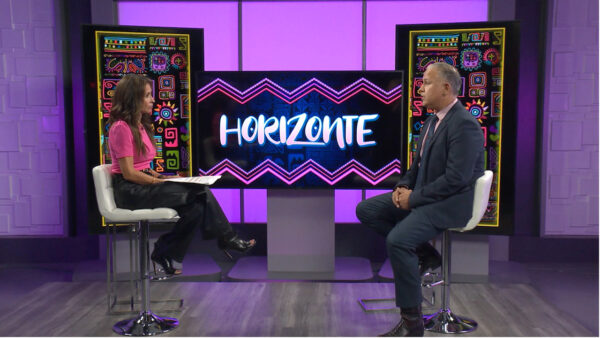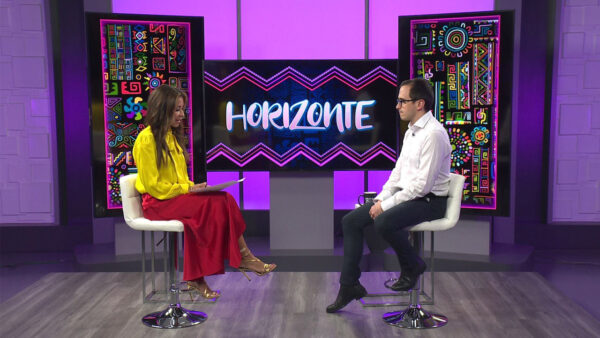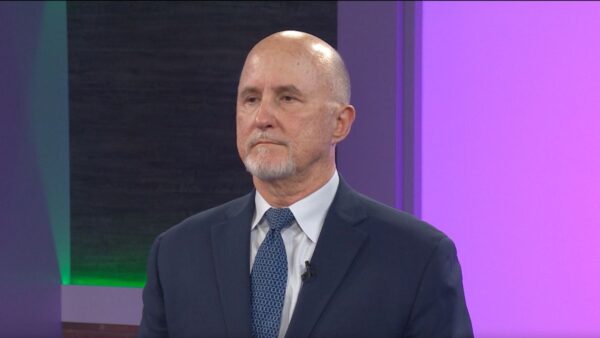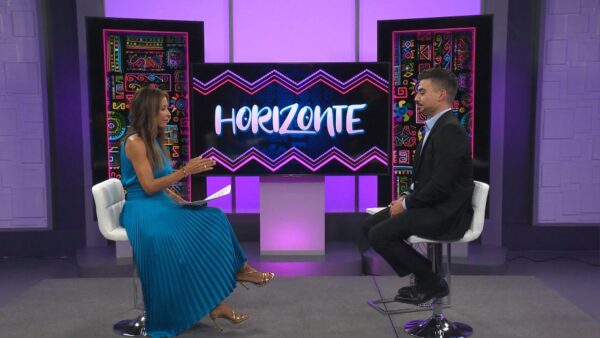Her work has focused on artistic practices and cultural expressions in Arizona and the U.S Mexico borderlands. Meet Casandra Hernandez Faham, Executive Director for CALA Celebracion Artistica de las Americas and serves as a curator of CALA Initiatives for the Arizona State University Art Museum.
{VIDEO}: "horizonte" is made possible by contributions from the friends of Arizona PBS. Members of your PBS station. Thank you.
JOSE CARDENAS: Good evening and welcome to this special enfoque edition of "horizonte." I am José Cardenas. Tonight, Cassandra Hernandez faham, she is a native of Hermosillo Sonoran she spent her life on both sides of the Sonora Arizona border her work has focused on artistic practices and cultural expressions in Arizona and the U.S.-Mexico border lands. Her focus now is on CALA. Celebracion artistica de las americas. In English, celebration of the arts of the Americas, she is the executive director of CALA initiatives a nonprofit that connects Arizona and Phoenix to Mexico and Latin America through the arts. She is also the curator for CALA initiatives of the Arizona state university art museum. Cassandra Hernandez faham, welcome to "horizonte."
CASANDRA HERNANDEZ FAHAM: Thank you so much for having me.
JOSE CARDENAS: So word that is that you started your career as a child star on television in Hermosillo.
CASANDRA HERNANDEZ FAHAM: I guess I did. My mom had a tv show growing up, and now that I look back on footage of those cooking shows I realize that she was quite avant-garde. She had a vegetarian cooking show in the meat capital of the nation and it was filmed in our home. And I made cameos growing up many times. And one day actually I was meeting a friend of my parents for the first time and he asked my name and he is asking me all kinds of questions and said, well, Cassandra who, and I said from tv. It was very much --
JOSE CARDENAS: You did do yourself as a TV star
CASANDRA HERNANDEZ FAHAM: You i can't, very much part of my destiny. It was something that I really enjoyed doing.
JOSE CARDENAS: So in addition to being a celebrity took, your mother was also a teacher and that's what brought you and your family to Phoenix Arizona when you were 15, right?
CASANDRA HERNANDEZ FAHAM: When I was 18. So right after high school my mother who taught in Mexico for 20 years decided to immigrate with the whole family like many families do. You know, seeking opportunities and seeking in this case, you know, educational opportunities for my brother and I. So we move to Phoenix, Arizona, and I have been in Phoenix ever since, this was in 2001.
JOSE CARDENAS: A graduate of Arizona state university?
CASANDRA HERNANDEZ FAHAM: I am, yeah.
JOSE CARDENAS: With a degree in cultural anthropology.
CASANDRA HERNANDEZ FAHAM: That's right.
JOSE CARDENAS: What does that mean?
CASANDRA HERNANDEZ FAHAM: It means I have always been very interested in how culture is the place where we create narratives about ourselves and about each other. I have been really fascinated by the way that different groups of people come up with, you know, roots for life, with moral codes, with traditions, practices, arts. So I decided That I wanted to focus my career and studies in that field. And I spent a lot of time as an undergraduate in central Mexico doing work with material culture, with objects, thinking I would work in a museum one day. And then as I, you know, spent more and more time in classes and then I eventually went for a graduate degree, I realized that what I was most interested in where those cultural expressions that were happening right now in this moment.
JOSE CARDENAS: And here in Phoenix where did you find those opportunities?
CASANDRA HERNANDEZ FAHAM: For --
JOSE CARDENAS: To experience the same kind of things that you were director at one of the museums that ASU operates?
CASANDRA HERNANDEZ FAHAM: Yes. I think when I made that shift, I realized that I was very much interested in how people in real time were coping with things that were happening politically, how artists in particular were creating work that addressed these larger questions about our humanity. About, you know, the kind of society that we wanted to produce because I think at the end of the day, artists don't produce objects or commodities, they are producing a kind of society that we want to be in. So I started working at the ASU deer valley rock art center, now it's called the deer valley petroglyph preserve. This is a really-- an incredible space in Phoenix which is an archeological site and a 47-acre nature preserve, and there are petroglyphs which are able she want carvings on rocks. Made by the first inhabitants of the desert all the way to the hohokam, which, you know, made one of the largest civilization in the Phoenix valley. I was very, at the time, very interested in creating connections about the deep history of groups in the area. And our contemporary identity as desert people, how we think about landscape, water, how are we thinking about the fact that we have these really, really long cultural histories and we see people from all over the world trying to make sense of living in this desert.
JOSE CARDENAS: And I should mention that I am on the board of directors of cost, so I know some of what you are talking about is also connected to the work that you are doing at CALA. But before we get there, you work with the Arizona commission on the arts.
CASANDRA HERNANDEZ FAHAM: Yes, I work at the Arizona commission of the arts and artists programs coordinator, and at that time I was very interested in figuring out, you know, structures of support for artists in Arizona. And in figuring out, you know, how to create platforms to support, you know, the very vital contributions that they make in our state.
JOSE CARDENAS: You work at the commission, focusing on the relationships not only between Arizona artists but between those artists and international, national artists and communities in Arizona. Explain how that works.
CASANDRA HERNANDEZ FAHAM: Yeah, so when I was at the commission, I created the program that's still in existence called ACR worker and the idea with this program was to connect local artists, Arizona artists with artists that were coming from all over the world to do work here and then create a sort of professional development program where artists then had opportunities to train with national, international artists and also with each other. And, you know, also a program that highlighted the vital contributions of artists in our communities in terms of, you know, the issues That we think about all the time.
JOSE CARDENAS: Your work has been recognized in a number of ways. You were selected as one of the 40 under 40 Hispanic leaders in Phoenix. You are also a fellow of NALAC, an arts organization, the leadership Institute. Elaborate on your involvement in the national scene. In Latino art.
CASANDRA HERNANDEZ FAHAM: Yeah, so I was fortunate to be selected to be part of a very, very important leadership institute ran by the national association of Latino arts in culture and this was a convening of people doing work in Latino arts nationally. And it's one of the best programs out there for Latino artists, culture makers, cultural bearers, arts administrators, anybody who is interested in gaining a national perspective of the work that is happening right now.
JOSE CARDENAS: We mentioned that you grew up on both sides of the border. You have been quoted in other interviews as saying that the people in Sonora know the -- know Phoenix very well. People in Phoenix know very little about Sonora, what do you think that is attributable to?
CASANDRA HERNANDEZ FAHAM: You know, it was -- I think it was one of the most surprising things when I moved from Hermosillo to Phoenix at the age of 18, that people would ask me, I think, you know, I could get away with maybe two words before people realized I had an accent and then of course the next question would be where are you from. And I would respond Hermosillo very naturally and I realized very quickly that most people didn't know where that was. Couldn't even locate it on a map. So I found it surprise that go A lot of people in Sonoran even if they had not been able to travel to places like Tucson or Phoenix they had an understanding and an imagination of what was north of them. And I found it really shocking to discover that here in Arizona, there was very little imagination about what was south of the border. So when I decided to, you know, start doing cultural work, I was very interested in investigating why, you know, that was the case. And I untangling sort of the narratives that exist in our every-day lives. That would make people, you know, in Phoenix not think that they should know what's happening south of the border. We are part of the same Sonoran desert. Phoenix is a largest Metropolis, the largest city that has ever existed in the desert.
JOSE CARDENAS: And Arizona was part of the Sonora.
CASANDRA HERNANDEZ FAHAM: Arizona was once part of Sonora. We have the same cultural histories in terms of the indigenous groups who first inhabited these lands. We have contemporary indigenous tribes that straddle the border. I just find it really surprising that there isn't more connection and more culture flows.
JOSE CARDENAS: You talk about the lack of recognition from Phoenix to Sonora, but you also discussed the fact that south of Sonora, Mexico City, doesn't consider Sonora to be a place of culture, you have a famous line --
CASANDRA HERNANDEZ FAHAM: Yes.
JOSE CARDENAS: About culture ends where the Carne Asada for which Sonora is famous begins?
CASANDRA HERNANDEZ FAHAM: Yes. so I come from generations of desert, borderlands dwellers. My family on both sides is from a small town in Magdalena, Sonora, so I spend A lot of time near the border, and then also in Hermosillo, of course, and I would hear, you know, these side comments that people would make as jokes, like, you know, culture stops where carne Asada begins, and these were comments made by people in Mexico City or people in Central Mexico. Meaning that the north of the country was devoid of any kind of cultural contribution and it was just a land of carne Asada and not much more. And I always felt a little bit hurt my that comment because growing up I had been witness to many beautiful and incredible traditions where I was from. Going with my grandma they are to pick saguaro fruit, you know, learning about cooking from the women in my family. I mean --
JOSE CARDENAS: So there is a lot here that people should pay attention to.
CASANDRA HERNANDEZ FAHAM: Yes, there is a lot there.
JOSE CARDENAS: In many respects, Phoenix has kind of the same situation, though, the rest of the country does not, with some exceptions, consider Phoenix to be a cultural center, which brings us to CALA, which was founded kind of to deal with those perceptions to put Phoenix on the map as a cultural center, but one that focused on Latin America. Tell us about the origins of CALA.
CASANDRA HERNANDEZ FAHAM: So CALA was established in 2010 by a group of leaders in the Phoenix community who thought, you know, there was a space for an organization focusing on creating cultural connections between Arizona, Mexico, and Latin America. And so CALA existed as a festival of really important Latino arts festival for a number of years. And, again, with this idea of through art, connecting Phoenix and Arizona more deeply with art and culture that were happening south of the border. And I joined CALA 2 1/2 years ago, at the beginning of 2016, and so now we have -- you know, evolved in to a place where we are now, you know, creating different programs that focus on these connections and this cultural flows. So we work with local artists, we have exchange programs between American cities and Mexican cities.
JOSE CARDENAS: That is your residency program with Guadalajara.
CASANDRA HERNANDEZ FAHAM: Yes, we have a residency between Phoenix and Guadalajara where we fully support a Phoenix artist or Latina artist to spend six weeks in Guadalajara creating work, investigating any approaches and really immersing they go selves in a different -- themselves if a different cultural context. And conversely we host a Guadalajara artist in Phoenix to do the same. We put these two cities and their contemporary art scenes and dialogue and we are also supporting artists to create work that in some way, you know, reflects a different kind of connection between American and Mexican cities.
JOSE CARDENAS: So Cassandra, as I understand it, this is one of three floors of this exhibition here at the ASU art museum, “Saber Acomodar”, what is that mean and, what is the exhibition all about?
CASANDRA HERNANDEZ FAHAM: So this exhibition was co curated by the museum of contemporary art Denver and the asu art museum and CALA alliance collaborated to present Arizona. It looks at the last 100 years of production in Guadalajara by artists.
JOSE CARDENAS: The second largest city in Mexico.
CASANDRA HERNANDEZ FAHAM: Exactly. Contemporary artists but also by artisans and crafts people who are keeping, you know all kinds of traditional work alive, but also bringing it to contemporary practice.
JOSE CARDENAS: One of the most successful programs you brought to CALA has been cross state. Tell us about that one.
CASANDRA HERNANDEZ FAHAM: Yeah, so the cross state lab is an event series where we invite, you know, renowned Latino artists, from musicians, writers, people working in performance and new media.
JOSE CARDENAS: From many countries you have had some --
CASANDRA HERNANDEZ FAHAM: Yes. From Arizona, Mexico, las Inning America.
JOSE CARDENAS: Dominican Republic?
CASANDRA HERNANDEZ FAHAM: Dominican republic, Chile, so the idea is to create a cross state like the name applies, we’re taking this term from the DJ’s toggle bar that allows two inputs to be mixed to create something new and this is an idea. Created by Josh boone who is a professor in los angeles and a McCarthy award recipient he's been really interested in create this is metaphor for how we create knowledge and also how we create platforms for public discussion of, you know, ideas political, social, through art. So when you go to a lab you witness a conversation between two creators who work in very disciplines, come from vastly different locations and it's a mix of performance, discussion. The unexpected. It's a very unique event and it's been very well received in the sense that --
JOSE CARDENAS: I was going say one of the other things that you witness when you go to one of those events is the youth of the crowd. It seems like a pretty strong millennials crowd.
CASANDRA HERNANDEZ FAHAM: Yeah. It's a very beautiful crowd. It's very diverse. You know, it's a space where, you know, we embrace who we are in Phoenix I think in many ways cultural productions, cultural events are ways of responding to this narratives out there and also space where his we are creating new narrative about his who we are in Phoenix. So I think that when people respond to those kinds of spaces, I think it's resonating with something that has to do with how we -- how we see ourselves. I think at the end of the day, we are creating spaces of belonging. Where we are making statements about what kind of community we want to live in.
JOSE CARDENAS: We talked about the young people who go to cross state lab but an even younger group of Arizonans working through your literacy program. Talk about that.
CASANDRA HERNANDEZ FAHAM: We have a collaboration with Childs play and the ASU art museum where we create residencies in elementary schools and we focus on Latino or Latin America or at this time. Last year , for example, we focused on Celia Cruz.
JOSE CARDENAS: Celia Cruz the famous Cuban singer.
CASANDRA HERNANDEZ FAHAM: La Reyna De La Salsa. Yeah. Celia Cruz. And the schools who participate in this program get to work with Latino artists in the community with ChildsPlay teaching artist and says so the program includes reading bilingual books. Doing movement and drama exercises and then also creating an original piece of work that is then exhibited here at ASU art museum. So it's a very robust program where the intent is to, you know, think about who gets to become an artist, you know. And the title of the program is how it became an artist. Which is through exploring the story of a famous in this case Latino, Latin American artist with children, you know, we are trying to open a conversation about how traditions are made. How, you know, maybe an intuition or a particular butterfly, you know, can turn in to a career, can turn in to a lifelong passion. So --
JOSE CARDENAS: You have said in the past that what you are hoping to do is help Phoenix create a new vision for itself. What is that vision?
CASANDRA HERNANDEZ FAHAM: I think that for a long time, Phoenix has been in a certain kind of denial about where we are and where we come from. And where we can go. And I mean by that, that there is a kind of disconnection between our understanding and say our relationship to the desert landscape and the fact that we are desert peoples. We are the largest as I said city in the Sonora desert.
JOSE CARDENAS: And we kind of ignore the fact that we are a border state.
CASANDRA HERNANDEZ FAHAM: And the fact --
JOSE CARDENAS: Which brings me to one topic I want to focus on before we run out of time. CALA was created in 2010, which is also the year SP1070 kicked off.
CASANDRA HERNANDEZ FAHAM: Yes.
JOSE CARDENAS: Things seem to be quieted down for a while and now we are talking about walls. The president wants to build one, you have been quoted a number of times about tearing down walls. Just recently we had an Arizona representative basically saying that the lack of a common culture in his mind, is what is divided us and what will eventually destroy this country. What do you say to that?
CASANDRA HERNANDEZ FAHAM: I would say that the border unfortunately has become the place where the nation is projecting racial anxieties that have been there for a very long time. This is not something new. This reflects a fragility about a large segment of the population. And how they feel about the demographic changes in this country that are here and are coming. And I feel that when SB1070 happened it was a very clarifying moment for a lot of people living in this state. Where we got to understand the urgency and the stakes in answering to that kind of rhetoric and that kind of political narrative where we are told that we don't belong. Where we are told that we are not as good. That we should go somewhere else. And the answer to that is, you know, this is our home. We have been here, we have been here for a very long time. Communities are stronger when we celebrate the diversity, where we celebrate the contributions that we all make. And now it's the time to, you know, I hear a lot of talk about creating bridges, but if we are not going to even be allowed to create cultural bridges maybe we'll create cultural tunnels. Maybe this is the time to really think about what kind of society we want to be.
JOSE CARDENAS: Do you think though-- part of this message is that there isn't the assimilation that there has been in the past. He may be right or wrong on that. But how does CALA's emphasis on knowing about different cultures either further that or be the antidote and show that, yes, indeed, we have something in common?
CASANDRA HERNANDEZ FAHAM: I don't think that CALA alone can be an anecdote, but I think that we can be connected to an ecosystem of change. Nationally the conversation is changing. I think hopeful that there are many groups of people from grassroots movements to institutions and cultural organizations who are looking at this moment and saying, this is not who we are. And, you know, this country is about many ways of being and it's about, you know, creating a space where, you know, a world where many worlds can be a part of it. And so I feel that the cultural work is to create new cultural narratives. I really believe that. I feel that the only way to answer to this political discourse and this narrative of, you know, you don't belong here, is by creating other narratives to say we do, we all do. And, you know, we are not going anywhere.
JOSE CARDENAS: Cassandra, we are almost out of time. I want to touch very quickly on the fact that it's CALA alliance, and you do have partnerships with other institutions, give us about 30 seconds on that.
CASANDRA HERNANDEZ FAHAM: So CALA right now functions as a word -- you mentioned an alliance, we work with partners throughout Arizona and then also in Mexico and Latin America to create events, commissions, residencies, exchange programs, and so we are kind of nomadic practice in a way. A sort of entity that, you know, serves as a bridge between organizations, or as a, you know, convener in a sense.
JOSE CARDENAS: And on that note, we have to end the interview. Cassandra Hernandez faham thank you so much for join is you go on "horizonte."
CASANDRA HERNANDEZ FAHAM: Thank you so much for having me.
JOSE CARDENAS: And thank you for watching this special edition of "horizonte" enfoque, I am José Cardenas for Arizona pbs and "horizonte", have a good evening. ♪ ♪ ♪ ♪ ♪
{VIDEO}: "Horizonte" is made possible by contributions from the friends of Arizona PBS, members of your pbs station. Thank you.
Casandra Hernandez Faham: Artist




















